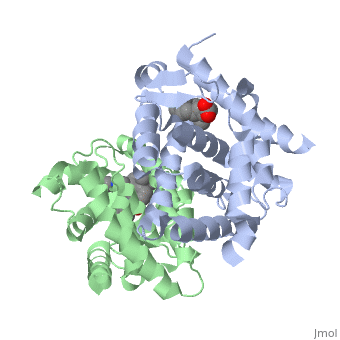RA Mediated T-reg Differentiation
From Proteopedia
(Difference between revisions)
| Line 50: | Line 50: | ||
==Biological Significance== | ==Biological Significance== | ||
Since T-regulatory cells are so highly regulated in the body, elucidating the exact mechanism of activation can show how these immune processes work, and use them in the treatment of disease. Two clear mechanisms of regulation arise from the studies, both which are related to the heterodimer itself. First, the ligand specificity for RA in both molecules allows for specific signaling of these molecules. RA is not normally expressed in cells, and therefore will limit when this heterodimer is activated. Likewise, the propensity for the heterodimer to associate with DR-5 repeats limits the number of genes it will activate to a select few. All of this in addition to the other cytokines necessary, TGF-β and IL-2, show the complex mechanisms regulating the differentiation of T-helper cells into T-regulatory cells. | Since T-regulatory cells are so highly regulated in the body, elucidating the exact mechanism of activation can show how these immune processes work, and use them in the treatment of disease. Two clear mechanisms of regulation arise from the studies, both which are related to the heterodimer itself. First, the ligand specificity for RA in both molecules allows for specific signaling of these molecules. RA is not normally expressed in cells, and therefore will limit when this heterodimer is activated. Likewise, the propensity for the heterodimer to associate with DR-5 repeats limits the number of genes it will activate to a select few. All of this in addition to the other cytokines necessary, TGF-β and IL-2, show the complex mechanisms regulating the differentiation of T-helper cells into T-regulatory cells. | ||
| + | |||
| + | ==3D structures of RXR and RAR== | ||
| + | [[Retinoid X receptor]] | ||
| + | [[Retinoic acid receptor]] | ||
</StructureSection> | </StructureSection> | ||
==References== | ==References== | ||
<references /> | <references /> | ||
Revision as of 07:57, 1 January 2015
| |||||||||||
References
- ↑ Ochs HD, Oukka M, Torgerson TR. TH17 cells and regulatory T cells in primary immunodeficiency diseases. J Allergy Clin Immunol. 2009 May;123(5):977-83; quiz 984-5. PMID:19410687 doi:10.1016/j.jaci.2009.03.030
- ↑ Moore C, Fuentes C, Sauma D, Morales J, Bono MR, Rosemblatt M, Fierro JA. Retinoic acid generates regulatory T cells in experimental transplantation. Transplant Proc. 2011 Jul-Aug;43(6):2334-7. PMID:21839265 doi:10.1016/j.transproceed.2011.06.057
- ↑ Moore C, Fuentes C, Sauma D, Morales J, Bono MR, Rosemblatt M, Fierro JA. Retinoic acid generates regulatory T cells in experimental transplantation. Transplant Proc. 2011 Jul-Aug;43(6):2334-7. PMID:21839265 doi:10.1016/j.transproceed.2011.06.057
- ↑ Kumar R, Thompson EB. The structure of the nuclear hormone receptors. Steroids. 1999 May;64(5):310-9. PMID:10406480
- ↑ Bourguet W, Vivat V, Wurtz JM, Chambon P, Gronemeyer H, Moras D. Crystal structure of a heterodimeric complex of RAR and RXR ligand-binding domains. Mol Cell. 2000 Feb;5(2):289-98. PMID:10882070
- ↑ Bourguet W, Vivat V, Wurtz JM, Chambon P, Gronemeyer H, Moras D. Crystal structure of a heterodimeric complex of RAR and RXR ligand-binding domains. Mol Cell. 2000 Feb;5(2):289-98. PMID:10882070
- ↑ Bourguet W, Vivat V, Wurtz JM, Chambon P, Gronemeyer H, Moras D. Crystal structure of a heterodimeric complex of RAR and RXR ligand-binding domains. Mol Cell. 2000 Feb;5(2):289-98. PMID:10882070
- ↑ Zhao Q, Chasse SA, Devarakonda S, Sierk ML, Ahvazi B, Rastinejad F. Structural basis of RXR-DNA interactions. J Mol Biol. 2000 Feb 18;296(2):509-20. PMID:10669605 doi:10.1006/jmbi.1999.3457
- ↑ Zhao Q, Chasse SA, Devarakonda S, Sierk ML, Ahvazi B, Rastinejad F. Structural basis of RXR-DNA interactions. J Mol Biol. 2000 Feb 18;296(2):509-20. PMID:10669605 doi:10.1006/jmbi.1999.3457
- ↑ Umesono K, Murakami KK, Thompson CC, Evans RM. Direct repeats as selective response elements for the thyroid hormone, retinoic acid, and vitamin D3 receptors. Cell. 1991 Jun 28;65(7):1255-66. PMID:1648450
Proteopedia Page Contributors and Editors (what is this?)
William Bailey, Alexander Berchansky, Michal Harel, Jaime Prilusky

